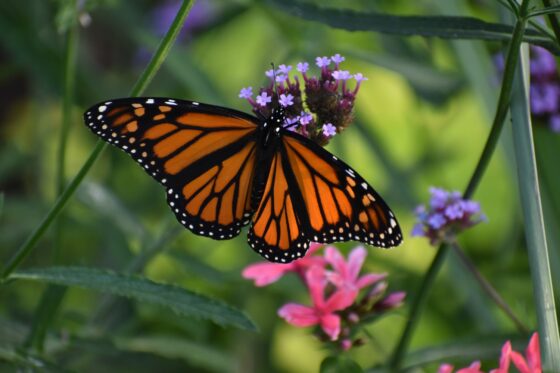Bug hotel: location, benefits & inhabitants
Insect protection in your own garden? A bug hotel is a useful way to support numerous beneficial insects in the garden.
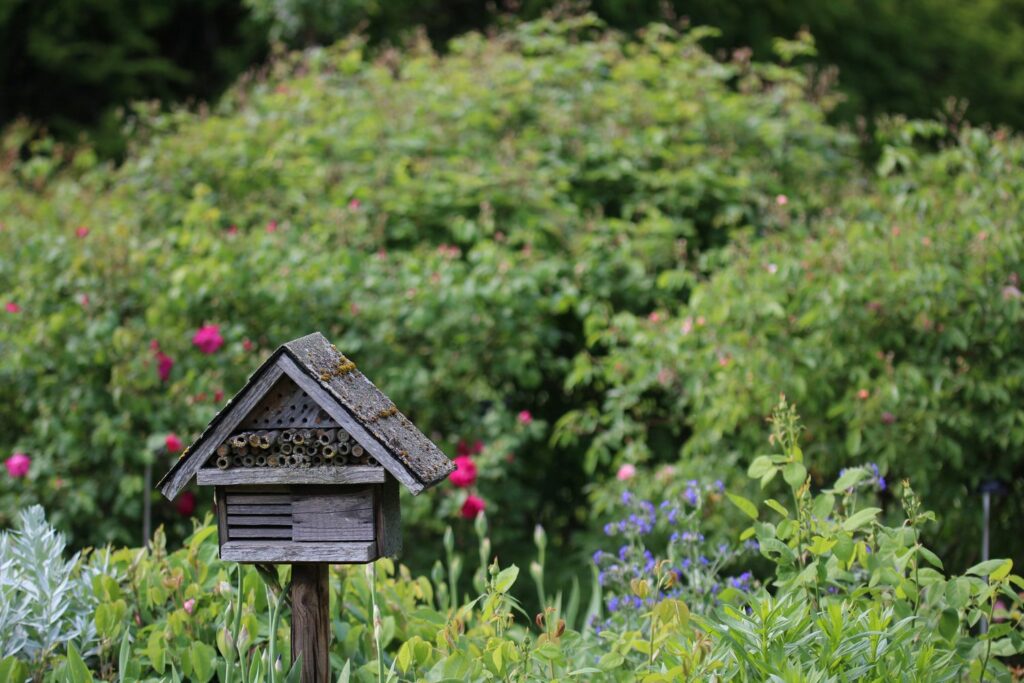
Protecting native insects in our gardens is becoming an increasingly important issue. Many insect species find insufficient food sources and hiding places in our country. To support beneficial insects, more and more people are installing insect hotels in their gardens. But is a bug hotel really useful? What to look for in a species-appropriate insect hotel? In our article you will learn everything important about the insect nesting aid.
Contents
Bug hotel: how do insect houses work?
An insect, bug or bee hotel is something most gardeners have seen before. But many ask themselves the question: how does an insect hotel actually work? In fact, the insect house has several uses. On the one hand, it serves as a shelter for various species of insects. However, reproduction is one of the main tasks of the bug hotel. The various materials of the insect nesting aid replicate natural shelters, which are normally used by insects as breeding burrows. Thus, the beneficial bug hotel is primarily a nesting aid for insects, as known, for example, from nesting boxes for birds. However, some bug hotel inhabitants also use them as hibernation aids.
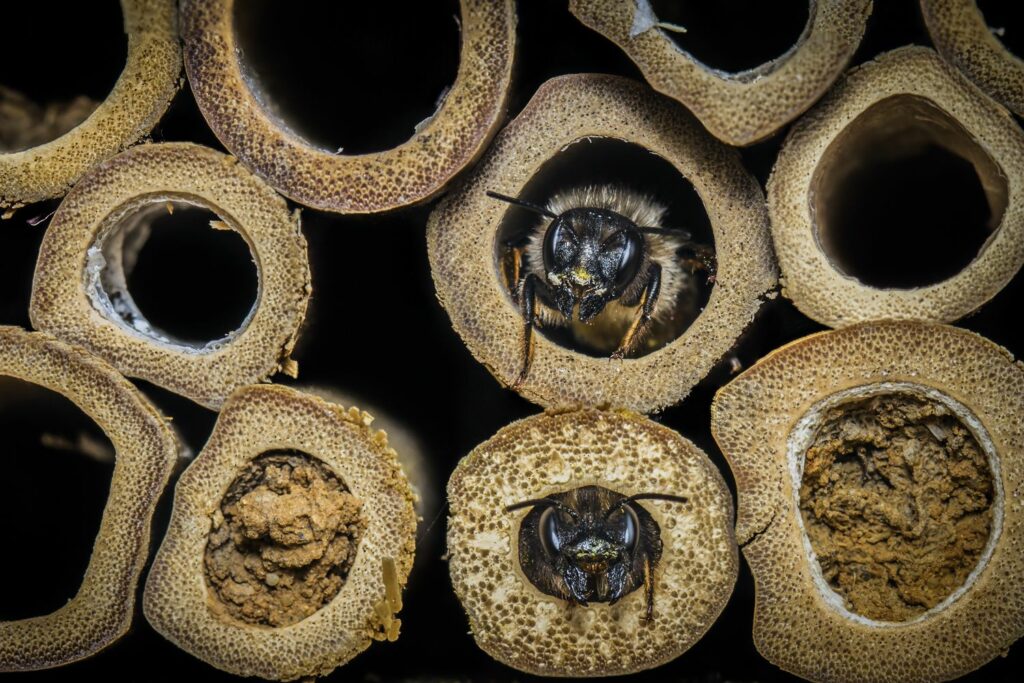
What are the advantages and disadvantages of insect hotels?
That an bug hotel has a benefit for its inhabitants becomes clear at first glance. But does it also bring benefits to your own garden? In fact, an insect hotel can enrich the garden: If it offers wild bees and other pollinators a suitable shelter, they are attracted to the garden and perform important work as pollinators. This can significantly increase the yield in the fruit and vegetable garden. If the insect hotel attracts ladybirds, green lacewings or ichneumon wasps, they decimate aphids and other pests. In addition, the construction and installation of an bug hotel can playfully awaken children’s interest in nature conservation and the local animal world.
Insect hotels have no disadvantages. But not all bug hotels are suitable for bees and other garden inhabitants: Unfortunately, models are offered again and again, which do not correspond to the image of a species-appropriate bug hotel.
In particular, the choice of the wrong materials can do more harm than good to the insects. For example, wild bees can injure their wings in the nesting box on wood that is too rough or the wrong material. Even transparent plastic or glass tubes can become a death trap. Although these are often offered with insect hotels, as they allow very good observations, the bee brood often fungi due to the high humidity inside. Therefore, always make sure to set up an bug hotel that is as species-appropriate as possible.
Allergy sufferers should also pay attention to the location of the insect hotel: There are often more bees in the vicinity, so the possibility of being stung increases. However, wild bees sting much less frequently than honey bees and often cannot even penetrate our skin with their often very weak sting. However, if you still want to be on the safe side, you should preferably not place the nesting aid for insects where you often spend time (for example, next to the terrace). If you still do not want to do without an bug hotel in the garden, you should place it in a more secluded part of the garden if possible.
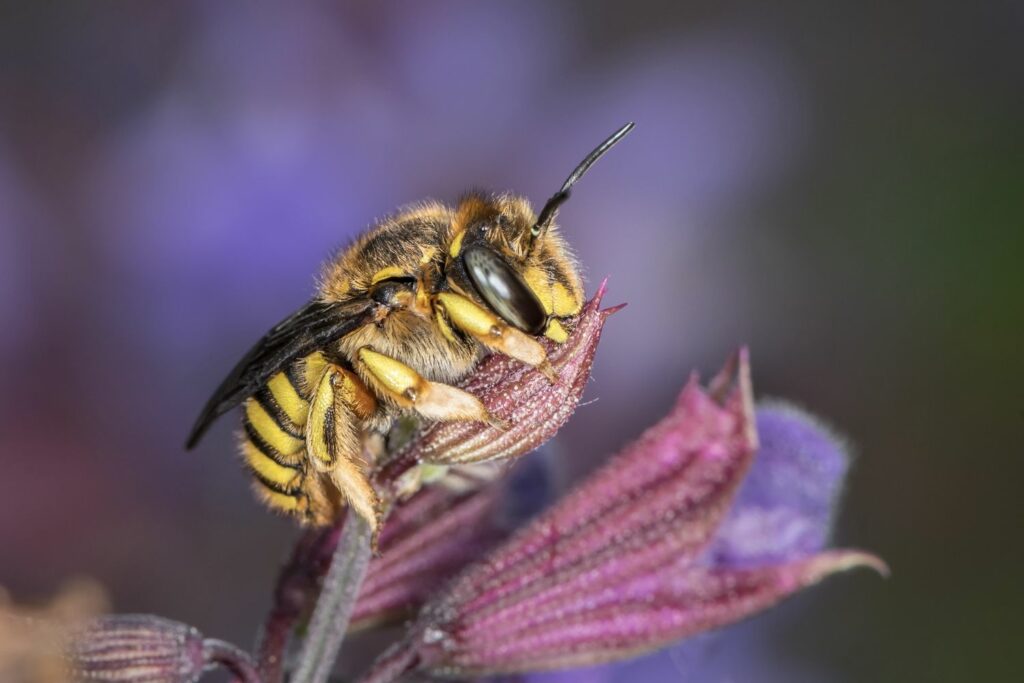
Here again the advantages of an insect hotel at a glance:
Advantage:
- Assistance with nature and species conservation
- Higher yield in the kitchen garden due to improved pollination
- Lower population of pests due to larger population of beneficial insects
- Playfully awakening interest in nature conservation among children
But be careful:
- Incorrect materials and processing can harm insects instead of benefiting them
Bug hotel inhabitants: for which insects is the hotel suitable?
If an insect hotel is well accepted, you will soon hear it buzzing and humming. But what insects go into an insect hotel? If you take a closer look, you will notice that numerous different animals can be observed. We have compiled an overview of the most common inhabitants of the bug hotel for you here.
Wild bees: Wild bees in the nesting box are probably the most favourite guests. Some of the almost 600 different species have very special characteristics, which is why not all of them accept nesting aids. However, you can do some species a big favour with the nesting aid. Bees can use different areas in the bug hotel: Some species prefer empty plant stems, while others prefer to nest in small holes in clay or wood. Cardboard tubes or reed stalks are also a favourite place of mason bees in the hotel. By the way, you can often tell if bees have moved in by looking at the holes in the insect hotel: If they are closed with clay, small stones or resin, the brood of a wild bee is probably behind them.
Ladybirds: Nesting boxes are often very well accepted by ladybirds. Unlike other insect species, however, the bug hotel for ladybirds does not serve as a breeding place (the eggs are laid on plants) but rather as a place of retreat in bad weather. In particular, boxes with wood shavings or dry leaves find favour with the ladybird.
Green lacewings: Whoever finds green lacewings in his hotel can be happy: These small inhabitants are important beneficial insects for us because their larvae feed mainly on aphids. The elf-like green lacewings with their translucent, veined wings are primarily crepuscular and hide under foliage and leaves during the day. However, the green lacewing also hides in boxes with wood wool or dry leaves in the bug hotel.
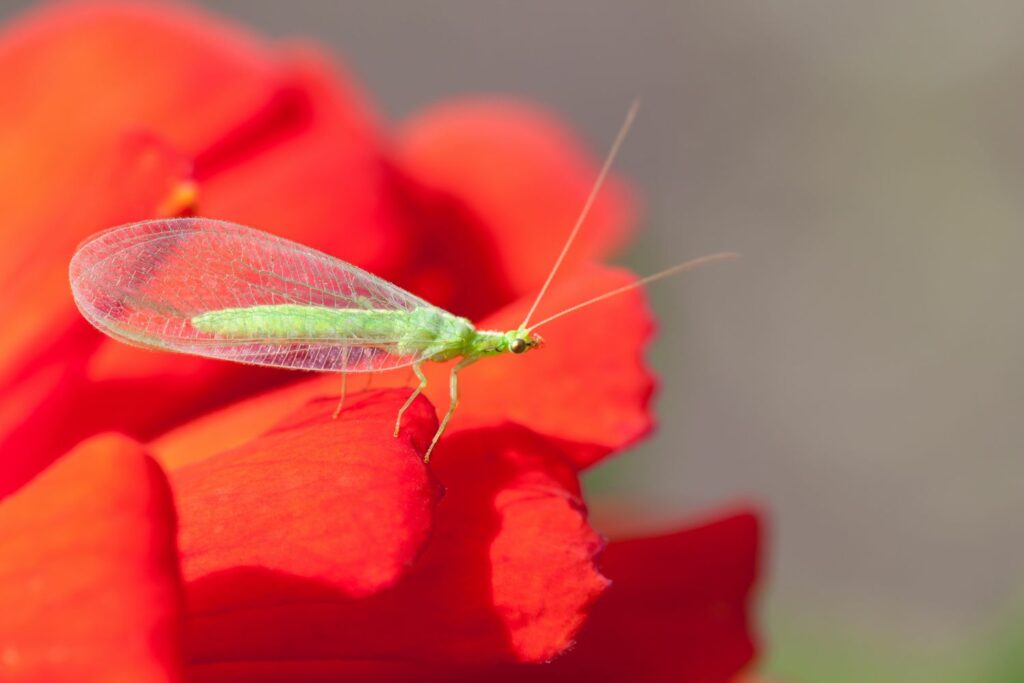
Earwigs: If you look closely, you can find earwigs in many insect hotels. The brown pincer beasts are extremely useful because they have an appetite for aphids and the eggs of many other pests. Wood wool or straw are ideal as quarters for these small animals and really attract beneficial insects. However, earwigs are also pollen thieves. Therefore, if bees are also to live in the insect hotel, it is recommended to place a separate bug hotel for earwigs in another place in the garden. Wild bees build up pollen stocks for their brood, which the earwigs love to steal. In the worst case, there will not be enough food for the offspring and the brood will starve to death.
Ichneumon wasps: With a size of only five to ten millimetres, ichneumon wasps are among the smallest inhabitants in the insect hotel. They are very popular with gardeners, despite their small size because they are known as reliable pest controllers. Of the more than 3300 different ichneumon wasp species, many representatives use bug hotels for shelter or overwintering. Ichneumon wasps are useful because they can be used for biological pest control: The female ichneumon wasps lay their eggs in other insects or their eggs and larvae. Once ichneumon wasp larvae hatch, they eat through their host, killing it.
Butterfly: Butterflies are among the few animals that use the insect hotel for hibernation. Some butterflies overwinter as adults and seek protected sites for this purpose. A box filled with brushwood as a seat with narrow slits for the entrance, makes the bug hotel ideal for butterflies to overwinter. Optionally, the butterflies can be offered not only the bug hotel but also a self built butterfly house.
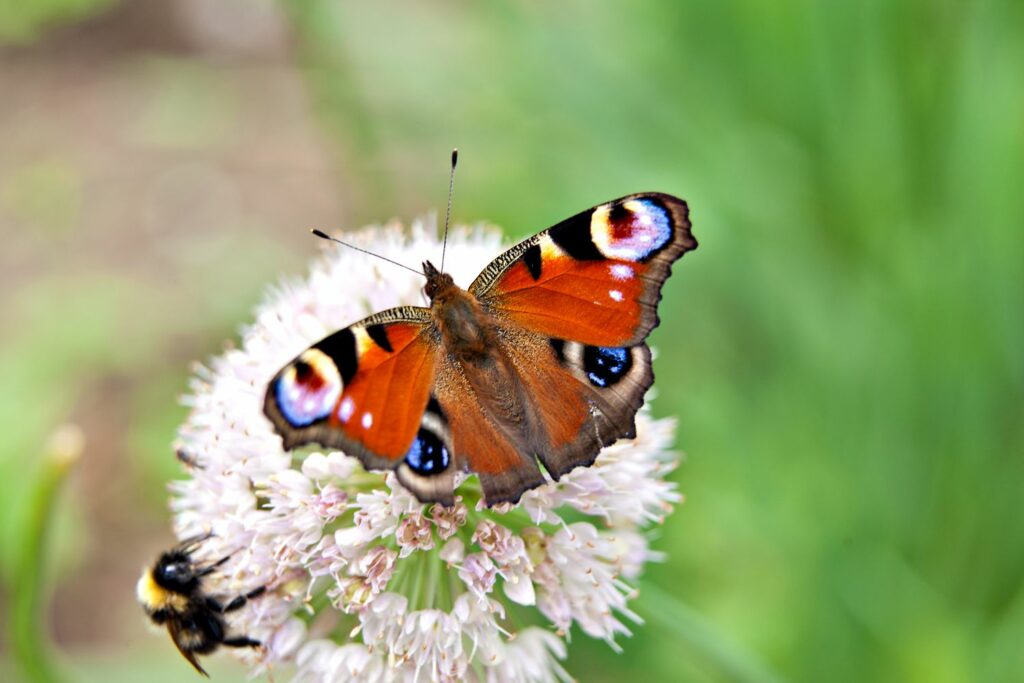
The right location for an insect hotel
The right location for the bug hotel is a decisive factor in whether the beneficial insects accept the insect house or not. Optimally, it is placed in a location that receives sunlight: The sun’s heat reduces the risk of fungus and rot and is needed by these industrious little animals for their brood. In addition, the best location for an insect hotel is one that is protected from wind and precipitation. But orientation is also crucial: The bug hotel should be placed at the location preferably in the cardinal direction south – so the nesting aid gets the most sun. On the other hand, the orientation of an insect hotel to the north-west should be avoided at all costs, as in Germany this side is usually exposed to bad weather. This means the insect hotel is in danger of being hit frequently by rain and wind. The best height for hanging the bug hotel is at least 75 cm or higher.
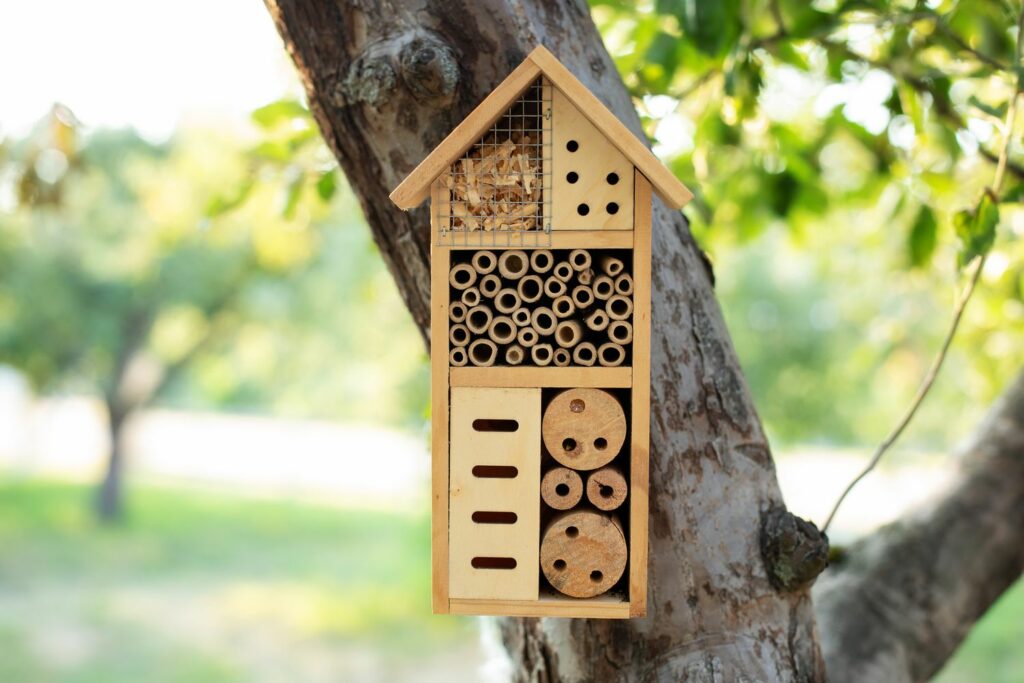
Where should you hang a bug hotel?
But where is the best place to put an insect hotel? There is no general answer here: if you pay attention to a sunny, protected location, you can place the bug hotel both on a house wall, and free-standing in the garden or on the balcony. Proximity to humans is not a problem for most insects. However, when locating the bug hotel, it is important to ensure that there is an adequate supply of food nearby: insect-friendly perennials and shrubs and insect-friendly flowers should be no more than 300 metres from the nesting aid to ensure that the animals feel comfortable. The more different insect-friendly plants are offered, the better. Diverse seed mixes are suitable here. Due to their diversity, they serve as a food source for various insects. In addition, wild bees in particular need sufficient raw materials such as water, sand and clay in the immediate vicinity to expand their nesting cavities. If you do not have these raw materials in your garden yourself or would like to set up the bug hotel on your balcony, you can also provide the natural materials you need on shallow bowls nearby.
Where to hang the bug hotel?
- Location: Sunny, warm, sheltered from wind
- Orientation: south
- Height: 75 cm or higher
- Forage plants: Insect-friendly plants within a radius of 300 m
- Environment: Provide clay, water and sand in shallow trays
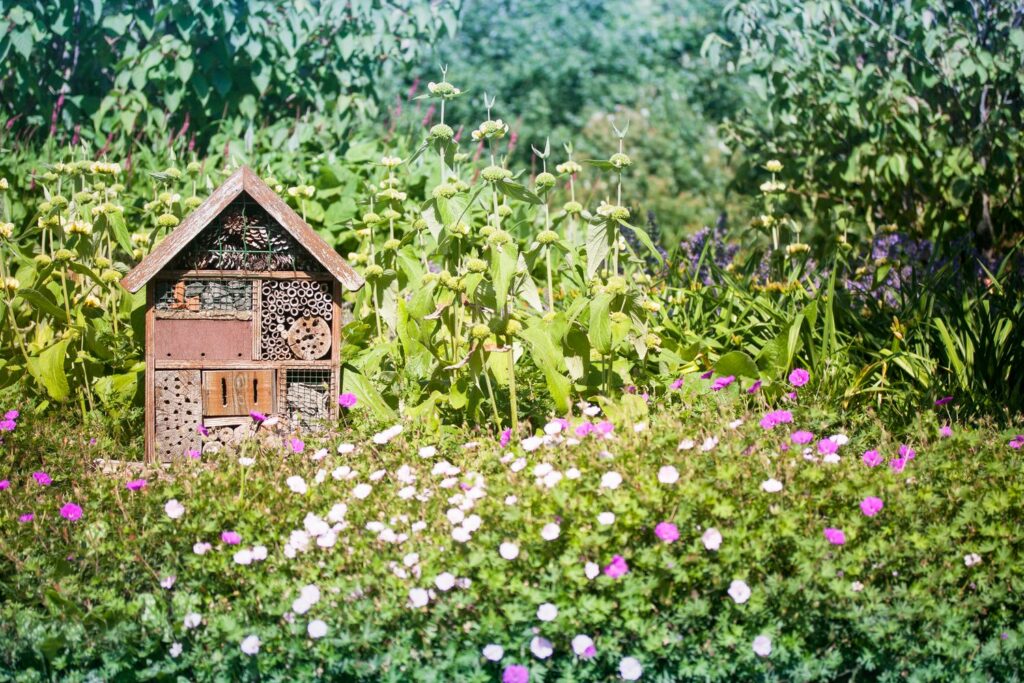
Protecting an insect hotel from birds
Whether you need to protect your bug hotel from birds, always depends on the individual location and conditions. But if you have already observed voracious birds pecking for food there, it makes perfect sense to attach a bird screen to the insect hotel. A good solution for protection from birds is to equip his bug hotel with a protective grid. A mesh size of three by three centimetres is ideal here, as this allows insects to pass through the bird screen, while birds are reliably kept out. If they want to protect your insect house with wire or equip it with a bird screen, in any case, pay attention to the necessary distance: the protective barrier should be at least five, preferably ten centimetres away from the nesting aid. This is the only way that longer-beaked bird species such as the woodpecker cannot get at the insects.
Care and maintenance
Many owners of an insect hotel wonder if it needs regular maintenance. In fact, regular maintenance of the bug hotel is not necessary. Instead, the bug should be left as undisturbed as possible because the industrious little animals use the nesting almost all year around. Therefore, the only part of bee hotel care is regular inspection for dilapidated or rotten components or mouldy filling material – they should replace this. In addition, you can carefully remove spider webs, which are located immediately in front of the holes of the insect hotel. In any case, you should not open closed tubes – here could still be hiding live brood. Even in winter it does not require special care. In any case, do not bring the bee hotel indoors in the winter. If insects do indeed overwinter in the nest box, the rapid rise in temperature may because them to awaken from their winter torpor and deplete their energy reserves.
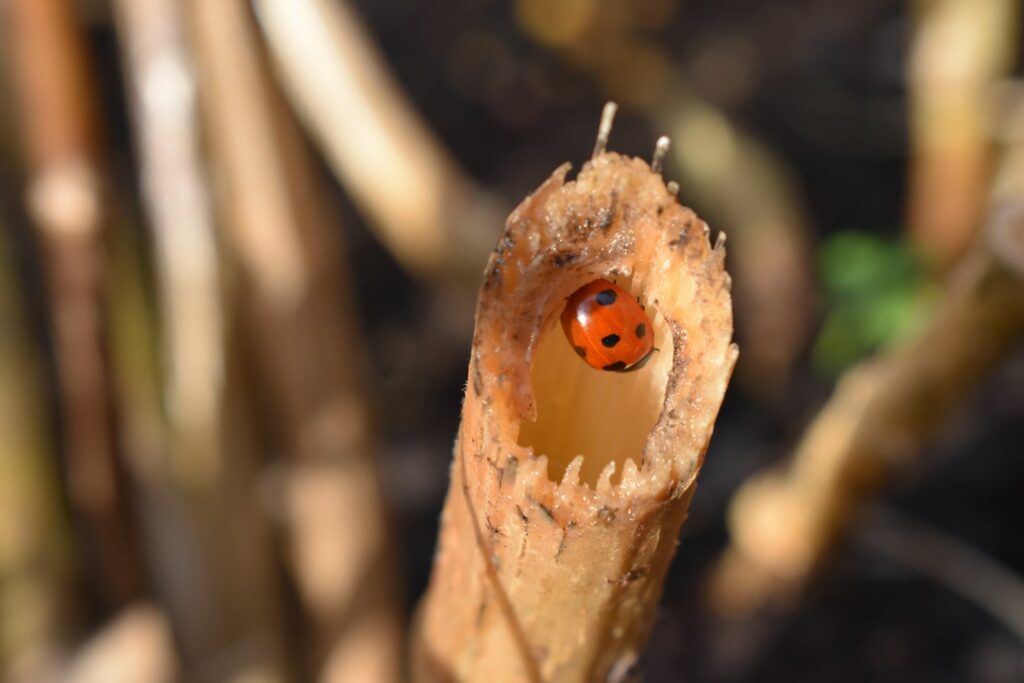
Insect hotel is not accepted?
You have set up an bug hotel and after some time you realise that there are still no inhabitants? Unfortunately, this happens again and again because various sources of error can make the nesting aid unattractive to insects. Now it is important to identify which factor interferes with the colonization of their insect house. The most common mistakes in the construction and installation of an insect hotel are as follows:
1. Wrong material used: Plastic, glass tubes, pine cones or fresh wood are poorly accepted or not accepted at all by most insect species. Softwoods are also not ideal for many wild bee species. Therefore, better suited for the construction of an bug hotel hardwoods such as oak, elm, oak, beech, hazelnut, chestnut or fruit woods.
2. Wrong hole size: If the holes are too big or too small, no new inhabitants will come into the insect hotel. Thumb-thick holes are much too large for bees and other insects, optimally the holes have varying diameters of between 2 and 9 millimetres.
3. Wrong location: If a bug hotel is hung at the wrong height or oriented to the wrong side, it becomes unattractive to insects. Therefore, always pay attention to the correct location for the insect hotel.
4. No food: The best insect hotel is of no use if the industrious beneficial insects cannot find food nearby. Therefore, be sure to plant insect-friendly flowers nearby.
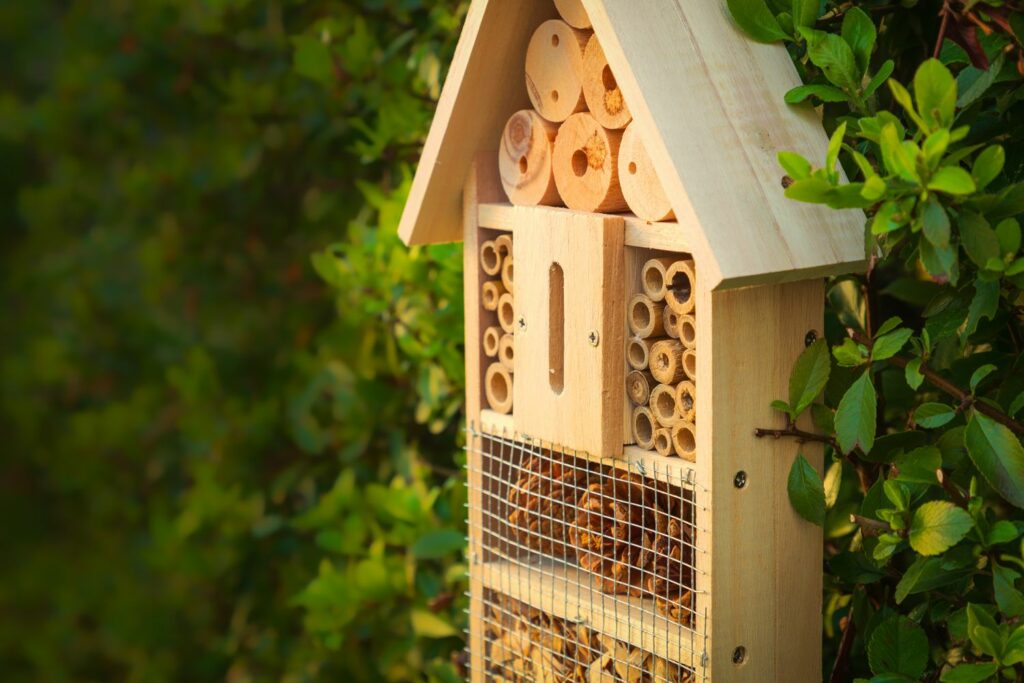
For a detailed explanation of how to avoid bug hotel mistakes and what to look for during construction, see our article on nesting boxes for wild bees.



















